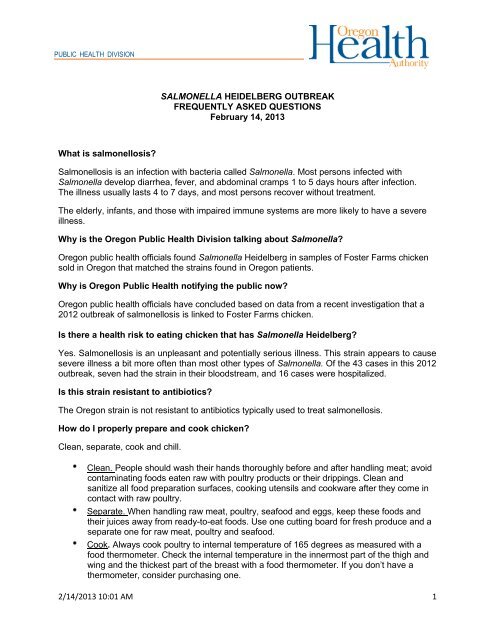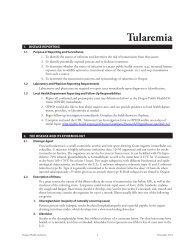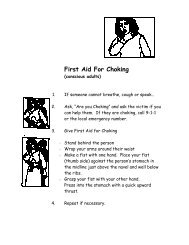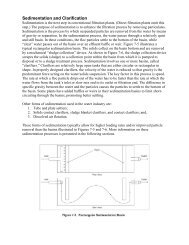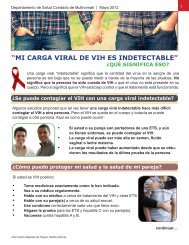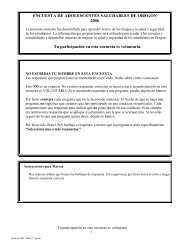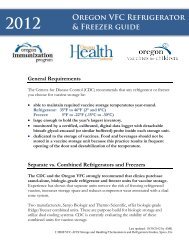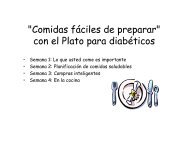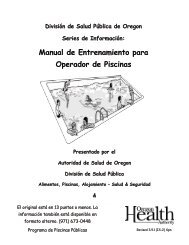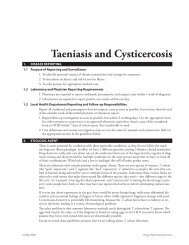FAQ: 2012 Salmonella Heidelberg Outbreak - Public Health
FAQ: 2012 Salmonella Heidelberg Outbreak - Public Health
FAQ: 2012 Salmonella Heidelberg Outbreak - Public Health
You also want an ePaper? Increase the reach of your titles
YUMPU automatically turns print PDFs into web optimized ePapers that Google loves.
PUBLIC HEALTH DIVISION<br />
SALMONELLA HEIDELBERG OUTBREAK<br />
FREQUENTLY ASKED QUESTIONS<br />
February 14, 2013<br />
What is salmonellosis?<br />
Salmonellosis is an infection with bacteria called <strong>Salmonella</strong>. Most persons infected with<br />
<strong>Salmonella</strong> develop diarrhea, fever, and abdominal cramps 1 to 5 days hours after infection.<br />
The illness usually lasts 4 to 7 days, and most persons recover without treatment.<br />
The elderly, infants, and those with impaired immune systems are more likely to have a severe<br />
illness.<br />
Why is the Oregon <strong>Public</strong> <strong>Health</strong> Division talking about <strong>Salmonella</strong>?<br />
Oregon public health officials found <strong>Salmonella</strong> <strong>Heidelberg</strong> in samples of Foster Farms chicken<br />
sold in Oregon that matched the strains found in Oregon patients.<br />
Why is Oregon <strong>Public</strong> <strong>Health</strong> notifying the public now?<br />
Oregon public health officials have concluded based on data from a recent investigation that a<br />
<strong>2012</strong> outbreak of salmonellosis is linked to Foster Farms chicken.<br />
Is there a health risk to eating chicken that has <strong>Salmonella</strong> <strong>Heidelberg</strong>?<br />
Yes. Salmonellosis is an unpleasant and potentially serious illness. This strain appears to cause<br />
severe illness a bit more often than most other types of <strong>Salmonella</strong>. Of the 43 cases in this <strong>2012</strong><br />
outbreak, seven had the strain in their bloodstream, and 16 cases were hospitalized.<br />
Is this strain resistant to antibiotics?<br />
The Oregon strain is not resistant to antibiotics typically used to treat salmonellosis.<br />
How do I properly prepare and cook chicken?<br />
Clean, separate, cook and chill.<br />
Clean. People should wash their hands thoroughly before and after handling meat; avoid<br />
contaminating foods eaten raw with poultry products or their drippings. Clean and<br />
sanitize all food preparation surfaces, cooking utensils and cookware after they come in<br />
contact with raw poultry.<br />
Separate. When handling raw meat, poultry, seafood and eggs, keep these foods and<br />
their juices away from ready-to-eat foods. Use one cutting board for fresh produce and a<br />
separate one for raw meat, poultry and seafood.<br />
Cook. Always cook poultry to internal temperature of 165 degrees as measured with a<br />
food thermometer. Check the internal temperature in the innermost part of the thigh and<br />
wing and the thickest part of the breast with a food thermometer. If you don’t have a<br />
thermometer, consider purchasing one.<br />
2/14/2013 10:01 AM 1
PUBLIC HEALTH DIVISION<br />
Chill. Uncooked poultry should be refrigerated no longer than two days and kept in the<br />
freezer no more than four months. Cooked poultry can be refrigerated for three to four<br />
days and frozen for two to three months.<br />
Should I stop eating chicken?<br />
Not unless you want to. Be aware that <strong>Salmonella</strong> and other bacteria are common on poultry<br />
products, and all raw poultry needs to be handled carefully to reduce the risk of illness; but if<br />
handled carefully and cooked well, chicken is safe to eat. Cooking chicken to an internal<br />
temperate of 165 degrees Fahrenheit will keep food safe from harmful bacteria.<br />
I don’t buy my chicken at a grocery store. Do I need to be worried?<br />
It doesn’t matter where your chicken comes from: health officials recommend careful handling<br />
and thorough cooking of all types of poultry. Remember, “clean, separate, cook and chill.”<br />
What should I do if I think I’m sick?<br />
People who have salmonellosis should not prepare food or pour water for others until their<br />
diarrhea has resolved. Most people recover without needing to see a doctor, but for some, the<br />
diarrhea may be so severe that treatment or hospitalization is required. Contact your health care<br />
provider if you are sick enough to need medical attention. Symptoms of severe salmonellosis<br />
include severe diarrhea or abdominal cramps, bloody diarrhea, and fever.<br />
Are there long-term consequences of <strong>Salmonella</strong> infection?<br />
Persons with diarrhea usually recover completely, although it may be several months before<br />
their bowel habits are entirely normal. A small number of persons with <strong>Salmonella</strong> develop pain<br />
in their joints, irritation of the eyes, and painful urination. This is called reactive arthritis. It can<br />
last for months or years, and can lead to chronic arthritis, which is difficult to treat. Antibiotic<br />
treatment does not make a difference in whether or not the person develops arthritis.<br />
Do you know where the chicken in this outbreak came from?<br />
Most of those who got sick reported eating chicken, and most of those who could recall the<br />
brand of chicken eaten reported that it was Foster Farms-brand chicken. In addition, the strain<br />
of <strong>Salmonella</strong> <strong>Heidelberg</strong> found in the stool samples of those who fell ill matched the strains<br />
found in retail poultry purchased and tested by the Oregon State <strong>Public</strong> <strong>Health</strong> Lab, leading<br />
epidemiologists to conclude that Oregonians who were infected by this particular strain<br />
contracted it from handling or eating Foster Farms chicken.<br />
My neighbor has 3 chickens in his back yard. Does that pose a risk to my kids?<br />
It is prudent to assume that chickens and other animals may be carrying <strong>Salmonella</strong>. You can<br />
reduce your risk by frequent and thorough hand washing when you are out in the yard, your<br />
garden, or your farm — anywhere wild and domestic animals may be.<br />
2/14/2013 10:01 AM 2
PUBLIC HEALTH DIVISION<br />
How do public health officials find out which food is making people sick?<br />
One way public health officials find outbreaks is through disease reporting. By gathering reports<br />
of certain types of illnesses all the time, they know how many illnesses to expect in a given time<br />
period in a given area.<br />
If a larger number of people than expected appear to have the same illness in a given time<br />
period and area, it’s called a cluster. When an investigation shows that ill persons in a cluster<br />
have something in common to explain why they got the same illness, the group of illnesses is<br />
called an outbreak.<br />
How often do Oregon <strong>Public</strong> <strong>Health</strong> Division employees go out and buy chicken from<br />
stores?<br />
Oregon participates in something called the National Antimicrobial Resistance Monitoring<br />
System (NARMS), a multi-state project that monitors the presence of <strong>Salmonella</strong> and<br />
Campylobacter (another bacterium that causes diarrhea) in retail chicken. Staff from the Oregon<br />
State <strong>Public</strong> <strong>Health</strong> Laboratory purchase chicken from retail grocery outlets in the region once a<br />
month, typically buying 10 individual packages of chicken breasts, and test them for these<br />
bacteria.<br />
How often is poultry contaminated with bacteria that cause diarrhea?<br />
On average during 2007–2011, 6% of chicken specimens tested had <strong>Salmonella</strong>, and 37% had<br />
Campylobacter (another bacterium that causes diarrhea).<br />
How many people got sick in the <strong>2012</strong> outbreak?<br />
During <strong>2012</strong>, 43 individuals with this strain of <strong>Salmonella</strong> <strong>Heidelberg</strong> were reported among<br />
Oregon residents. CDC estimates, however, that for each case reported, there are about 25<br />
unreported cases — those who do not seek medical attention or whose doctors do not order a<br />
test for <strong>Salmonella</strong>.<br />
Cases of <strong>Salmonella</strong> <strong>Heidelberg</strong> infection with Foster Farms PFGE pattern, Oregon, <strong>2012</strong><br />
Oregon County<br />
Number of cases<br />
Clackamas 5<br />
Columbia 1<br />
Deschutes 2<br />
Douglas 2<br />
Harney 1<br />
Josephine 1<br />
Lake 1<br />
Lane 3<br />
Linn 1<br />
Marion 5<br />
Multnomah 6<br />
Polk 1<br />
Tillamook 2<br />
Union 1<br />
Wasco 2<br />
Washington 6<br />
TOTAL 40<br />
2/14/2013 10:01 AM 3
PUBLIC HEALTH DIVISION<br />
Is it common to get sick from a foodborne illness?<br />
CDC estimates that each year Americans suffer about 48 million instances of foodborne illness.<br />
Is this a recall?<br />
No. Oregon <strong>Public</strong> <strong>Health</strong> does not issue recalls. Generally speaking, recalls are done by<br />
private companies.<br />
Should I bring my product back to a store?<br />
No. If carefully handled and thoroughly cooked, the product is safe to eat.<br />
Did scientists test any other brand of chicken, and did any of it have salmonella?<br />
Yes, public health scientists tested other brands of chicken, and other strains of <strong>Salmonella</strong><br />
were found. However, we found the particular strain of <strong>Salmonella</strong> <strong>Heidelberg</strong> associated with<br />
this outbreak only on chicken processed by Foster Farms.<br />
2/14/2013 10:01 AM 4
PUBLIC HEALTH DIVISION<br />
Can you tell me the names of the people who got sick in <strong>2012</strong>?<br />
No. Oregon law precludes us from releasing names of cases reported to us. See ORS 433.008.<br />
Were there any fatalities in the <strong>2012</strong> outbreak?<br />
No. There have been no fatalities in the <strong>2012</strong> outbreak.<br />
Do we know if they got sick in <strong>2012</strong> from undercooked chicken or from coming in contact<br />
with contaminated surfaces/utensils?<br />
No, we don’t know. However, we know that cross-contamination can play a role in getting<br />
salmonellosis — and cross-contamination may indeed more be more important than<br />
undercooking.<br />
What is cross-contamination?<br />
Cross-contamination is when bacteria are spread from one surface to another, like a cutting<br />
board to a sponge. When handling raw meat, poultry, seafood and eggs, keep these foods and<br />
their juices away from ready-to-eat foods. Always start by cleaning everything: wash hands with<br />
warm water and soap; wash cutting boards, dishes, and utensils with hot soapy water or a<br />
dishwasher. Sanitize surfaces such as sinks and countertops with disinfectant solutions such as<br />
chlorine bleach. Use separate cutting boards if possible for raw meats and other fresh,<br />
uncooked foods, like fruit. Bacteria can live for days on a cutting board surface, if it is not<br />
properly washed. Sponges are a common source for cross-contamination; wet sponges should<br />
be routinely “cooked” in a microwave until they are steaming hot or rinsed in a disinfectant.<br />
2/14/2013 10:01 AM 5


